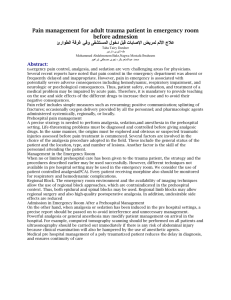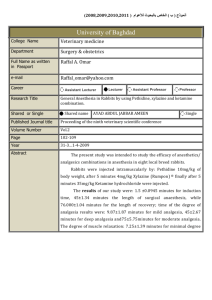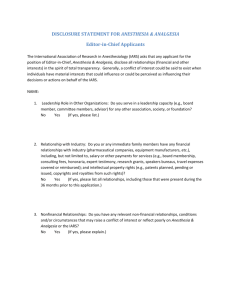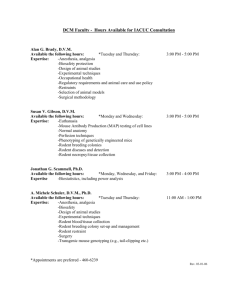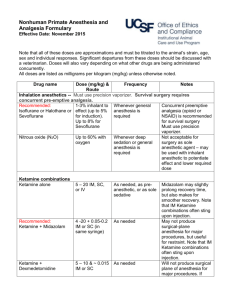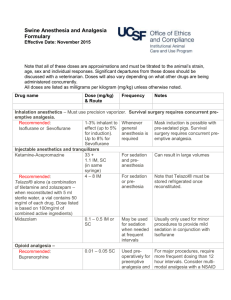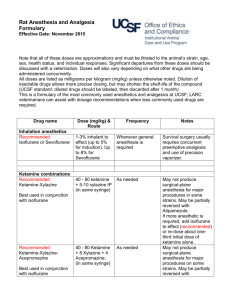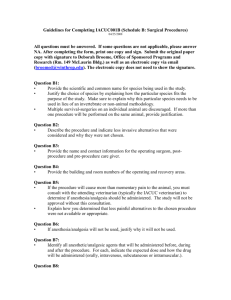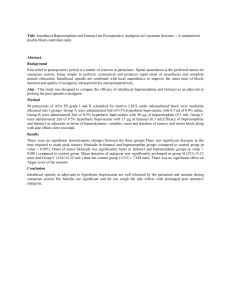Pain - Emergency Medicine Education
advertisement
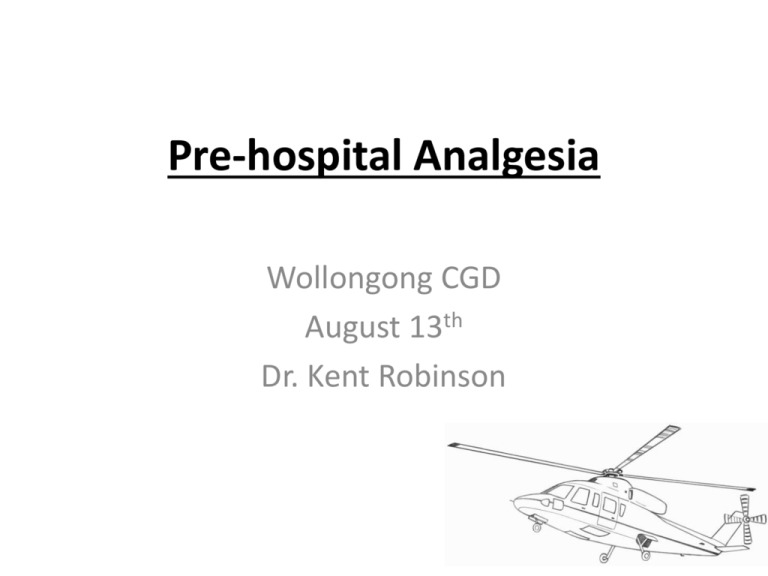
Pre-hospital Analgesia Wollongong CGD August 13th Dr. Kent Robinson Pain • Pain is a common presentation. • 78-86% of all presentations to the ED are for pain related issues. • Oligoanalgesia is common with the vast proportion of our patients not receiving adequate analgesia. • Minimal research done on the topic of pre-hospital analgesia. Summary • Analgesia should be given early to patients in acute severe pain. • Intravenous analgesia should be aggressive and titrated to effect – Results in better analgesia – Results in reduced dosages of medications Summary • Opiates should be the mainstay of analgesia – Consider the use of titrated fentanyl • Rapid onset of action • Quicker time to effective analgesia • Use ketamine as an opioid sparing agent • Consider the use of targeted analgesia such as local anaesthetic nerve blockade Pain History • Site of pain – Location – Radiation • Circumstances associated with pain onset • Character of pain • Intensity of pain – – – – At rest On movement Duration of pain Aggravating or relieving factors Pain History • Associated symptoms (nausea) • Effect of pain on sleep and activities • Treatment – Current and previous medications (dose, frequency, efficacy and side effects) – Other treatments (TENS) – Health professionals consulted • Relevant past medical history Pain History • Factors influencing the patients symptomatic treatment – Belief concerning the cause of pain – Knowledge, expectation and preferences for pain management – Expectations of pain treatment – Reduction in pain required for patient satisfaction – Typical coping response for stress or pain (past history of psychiatric disorders) Measurement of Pain • Complex and difficult to measure • Pain is an individual and subjective experience • There are no objective measures for pain – Hyperalgesia – Stress response (cortisol levels) – Behavioral response (facial expressions) – Functional impairment – Physiological responses (changes in heart rate) Numerical Rating Score Verbal Descriptor Scale • Best choice in elderly patients including patients with mild to moderate cognitive impairment. • This type of scale uses descriptor terms such as none, mild, moderate, severe and excruciating General Principles of Pain Care • Many factors can add to the pain – Situation – Movement of patient – Procedures (cannulation, limb splintage, spinal care) • Patients may be anxious or confused and not think to ask for pain relief. • Good analgesia facilitates patient care. General Principles of Pain Care. • Appropriate analgesia should be given via an appropriate route in the shortest time frame possible. • Reassessment of pain should occur to determine the effect of treatment. If pain is severe this should happen every 5-15 minutes (severe pain is defined as a pain score greater than 7). Less severe pain should be reassessed every 30-60 minutes. General Principles of Pain Care • Pain relief has medical benefits – Reduction in pain related tachycardia – Improved in lung function – Reduction in PTSD • Consider targeted analgesia • Pain relief should be ongoing to avoid “wind-up” and increased analgesia requirements • If aggressive with analgesia, total requirements will be lower. General Principles of Pain Care • Patients with severe injuries may require high doses of analgesics which may depress their level of consciousness. – Cause hypoventilation and hypercarbia – Necessitate intubation for analgesic control. Methoxyflurane • Halogenated ether • Highly potent and lipid soluble • Powerful analgesic • Nephrotoxic and hepatotoxic - dose dependent effect (anaesthetic dosages) • Reduce pain sensitivity by altering tissue excitability Methoxyflurane • Extensively used in Australia and New Zealand in the pre-hospital setting • Inhaler – green whistle • 3 ml dose – lasts approximately 30 minutes • Maximum recommended dose is 6 ml per day due to concerns about dose related nephrotoxicity • Pain relief takes effect after 6-8 breaths and continues for several minutes after discontinuation of the drug. Morphine • Naturally occurring alkaloid derived from opium • Strongly lipophobic • Onset time is 5 minutes • Peak effect is 10 minutes • Duration of action 1-4 hours Morphine • Dosage 0.05-0.1 mg/kg (repeat to effect) • Moderate sedative effect • Potent metabolites – analgesia and respiratory depression • Unlikely to cause apnea at therapeutic doses. Morphine • Gold standard for analgesia in severe pain • Average dose to control acute severe pain is 0.4 mg/kg Fentanyl • • • • • • Synthetic opioid Highly lipophilic Onset time < 1 minute Peak onset 2-3 minutes Duration of action 30-45 minutes Dosage 0.25-0.5 mcg/kg (repeat to effect), maximum dose of 100 mcg (equivalent to 10 mg Morphine) Fentanyl • Causes minimal sedation • No active metabolites • High risk of apnea at therapeutic dosages • High risk of chest wall rigidity syndrome • Highly emetogenic compared to other opioids Chest Wall Syndrome • Muscle rigidity can occur with doses as low as 25 mcg in an adult. • Often confused with apnea caused by mu-1 receptor agonism. • Unable to resuscitate or ventilate patient unless given naloxone or neuromuscular blocking drug Fentanyl • Very efficacious • Rapid onset of action • Highly potent • Probably the least safe of the opioids available, but still has a very low side effect profile. Ketamine • • • • • • NMDA antagonist Rapid acting GA Profound analgesia Normal airway reflexes Increased skeletal muscle tone Stimulation of cardiovascular and respiratory system Ketamine • Contraindications – Severe hypertension would result in a hazard • Adverse Reactions – Emergence reactions occur in 12% of patients (lowest incidence in the young and elderly) – BP and HR are frequently elevated – Laryngospasm and bronchorrhoea – Tonic / Clonic movements mimicking seizures Ketamine • Sub-dissociative dosage of drug – 0.25 mg/kg, repeat every 30 minutes • Some studies recommend lower dosages of 1-2 mg boluses (Make up the drug into 1 mg/ml) • Paediatric dosage 0-4 mcg/kg/min • Background infusion of 0.25-0.5 mg/kg/hr if required. Ketamine The use of sub-dissociative doses of ketamine reduces the dosages needed of opiates Opiate sparing medication Ketamine • S+ ketamine is now becoming available • Traditional ketamine contains equivalent amounts of S+ and R- ketamine. • S+ Ketamine has 4 times the affinity for the NMDA receptor resulting in greater analgesic efficacy. Targeted Analgesia • Femoral nerve block – Indicated for injuries to thigh and knee – Landmarks include the inguinal crease and the femoral artery – Can improve accuracy of infiltration with the use of ultrasound Targeted Analgesia • Bupivacaine (Marcaine) – – – – 0.25% or 0.5% strengths Onset of action is 5 minutes Duration of action is 2-4 hours Duration of effect for nerve block is approximately 10 hours – Maximum dose is 2 mg/kg up to 175 mg/dose (35 mL 0.5%, 70 mL 0.25%) • For femoral nerve block, the volume of LA is generally 20 mL or less Summary • Analgesia should be given early to patients in acute severe pain. • Intravenous analgesia should be aggressive and titrated to effect – Results in better analgesia – Results in reduced dosages of medications Summary • Opiates should be the mainstay of analgesia – Consider the use of titrated fentanyl • Rapid onset of action • Quicker time to effective analgesia • Use ketamine as an opioid sparing agent • Consider the use of targeted analgesia such as local anaesthetic nerve blockade References • Kanowitz A et al. Safety and effectiveness of fentanyl administration for prehospital pain management. Prehospital Emergency Care. 2006; 10(1);1-7 • Galinski M et al. A randomized double-blind study comparing morphine with fentanyl in prehospital analgesia. Am J Emerg Med. 2005;23(2);114-119 • Borland et al. Options in prehospital analgesia. Emerg Med. 2002;14(1);77-84 • Prehospital analgesia in NSW, Australia. Prehospital & Disaster Med. 2011;26(6);422-426
